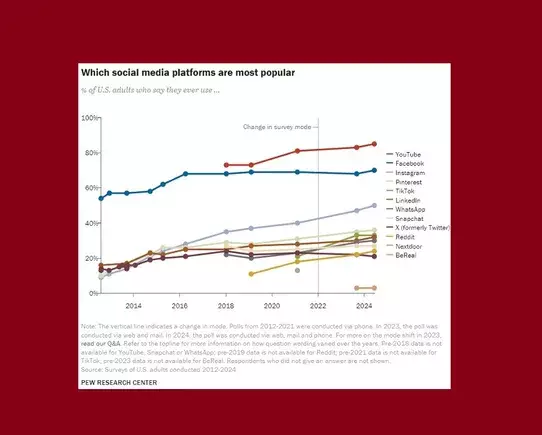In the digital era, social media has undeniably reshaped the way we communicate, share content, and connect with one another. Recent findings from the Pew Research Center offer a comprehensive overview of the prevailing trends in social media usage among U.S. adults, particularly regarding the relevance of various platforms. Among these platforms, YouTube continues to reign supreme, while the status of the platform formerly known as Twitter, now dubbed X, raises questions about its diminishing role in social interactions.
According to Pew Research’s latest survey—encompassing a robust sample of 5,626 U.S. adults conducted from February to June of this year—YouTube emerged as the most favored social media app. This finding is especially intriguing, as categorizing YouTube strictly as a social platform may be misleading. It primarily functions as a space for video consumption rather than active engagement, complicating its comparison with platforms like Facebook and Instagram, which facilitate direct interaction among users.
Facebook retains its foothold, particularly among older demographics, while Instagram remains a go-to platform for many, especially younger users. Pew’s data shows that approximately fifty percent of U.S. adults actively use Instagram, which underscores its significant presence in the social media landscape. However, the data suggests that as active engagement wanes, the relevance and utility of X (formerly Twitter) seem to be diminishing gradually.
In reviewing the data, it is crucial to distinguish between overall usage and engagement metrics. While the sheer number of users on platforms like YouTube, Facebook, and Instagram remains substantial, the time spent by users on those platforms varies significantly. For instance, TikTok has garnered a reputation for keeping users engaged far longer than other applications, reflecting an evolving landscape where engagement time may prove more valuable than user counts alone.
Moreover, while TikTok’s growth has plateaued within the parameters of this research, other platforms, such as Pinterest, are experiencing a revival, revealing the dynamic nature of social media trends. LinkedIn and WhatsApp also showcased slight increases in user numbers, indicating that professional and messaging platforms maintain their relevance amidst a rapidly changing digital environment.
Interestingly, while X is undergoing a subtle decline in its user base, it has not witnessed the catastrophic drop many predicted. This steady state calls into question the future trajectory of the platform and its capacity to capture new audiences. With the emergence of varied applications that cater to specific user needs—such as TikTok’s entertainment focus or Snapchat’s ephemeral content—X must find compelling ways to reengage its core audience.
Equally important are the insights regarding user demographics across different platforms. For example, TikTok and Snapchat have positioned themselves as the go-to applications for younger generations, starkly contrasting with Facebook’s aging user base. YouTube, while attracting diverse demographics, functions primarily as a video platform, challenging traditional notions of social engagement.
As these trends continue to unfold, businesses and marketers must adapt their strategies to align with shifting user behaviors. Understanding where audiences are most engaged can significantly influence marketing efforts, as brands must be present on platforms where their target demographics spend the most time.
Planning for 2025 requires adopting a nuanced approach to audience analysis, recognizing not just user counts but the quality of engagement across platforms. As newer social apps emerge and older ones evolve, remaining attuned to these shifts will be crucial for anyone looking to leverage social media effectively.
The evolving social media landscape, characterized by YouTube’s persistent dominance and X’s gradual decline, signals an imperative for businesses, marketers, and content creators to reassess their approach. The key to successful engagement lies in understanding and adapting to the nuances of these platforms, ensuring relevance in an ever-changing digital ecosystem.


Leave a Reply